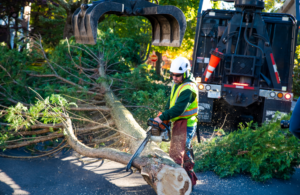Have you ever wondered about the safety of the trees around your property? Trees are attractive and necessary for our ecosystem but may also endanger people and property. This article will examine what tree risk assessment is, why it’s essential, and its procedure.
About Tree Risk Assessment and Its Procedure
Examining the possible dangers connected with a tree is known as tree risk assessment. Certified arborists, trained specialists with experience in tree maintenance and safety, provide this essential service. Specialists recommend an annual tree risk assessment.
During this assessment, an arborist will check the tree thoroughly to determine its health, structure, and possible threats. They will search for evidence of deterioration or decay, such as cracks or cavities, as well as termites or disease. They will also assess the tree’s structural integrity, including the strength of its branches, roots, and trunk.
The professional may employ specialized equipment, such as a tree climbing harness, to access various portions of the tree during the inspection. They may also utilize an acoustic tomography device to assess the tree’s wood density and strength.
Following the tree risk assessment’s completion, certified arborists will offer a full report describing their findings and suggestions for any necessary tree care or management. If the tree poses a serious risk to persons or property, this may entail trimming, cabling, bracing, or removal.

Reasons Why it May Be Necessary
- The tree is close to a structure, power line, or street, posing a risk to people and property if it falls.
- Harsh weather conditions, such as wind gusts, heavy snow, or ice storms, may have deteriorated the tree’s structural integrity.
- The tree has been trimmed or damaged in the past, which may have endangered its structural stability.
- An older or exotic tree may need extra care and attention to ensure its preservation and safety.
- The tree exhibits evidence of decay, illness, or insect infestation.
- The tree is leaning or has acquired a visible lean, indicating structural instability.
- The tree has enormous or overextended branches, which might collapse or break apart.
The Advantages:-
Increased tree health: A tree risk assessment may assist in building a strategy to repair and maintain the tree’s health by detecting concerns such as disease, insect infestations, or structural difficulties.
Savings: Identifying possible threats early with a tree risk assessment can save money on emergency tree removals and property damage.
Improved safety: A tree risk assessment can detect possible risks and reduce the chance of falling trees or branches, which can cause significant injury or damage to property.
Legal compliance: Property owners’ legal obligation is to protect the tree’s safety on their land. An assessment can assist in meeting these standards while also reducing liability concerns.
Environmental: Maintaining a healthy tree canopy provides several environmental benefits, such as improved air quality, wildlife habitat, and stormwater management.
Remember that the trees in our surroundings are lovely and crucial to the ecology. We can safeguard their safety and health for future generations by funding tree risk assessment and employing professional arborists.